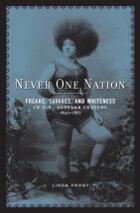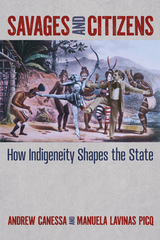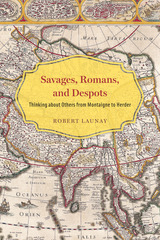3 books about Savages

Never One Nation
Freaks, Savages, and Whiteness in U.S. Popular Culture, 1850-1877
Linda Frost
University of Minnesota Press, 2005
In Never One Nation, Linda Frost argues that during the eventful decades surrounding the Civil War, American identity was constructed not only nationally but also locally. Depictions of race, class, and sexuality seen in P. T. Barnum's museums, in the image of the Circassian Beauty, and in popular periodicals like Harper's Weekly, the Southern Illustrated News, and the San Francisco Golden Era further illustrated who was - and who was not - an American. Local coverage of Native Americans and Chinese in the West, African Americans and recent Irish immigrants in New York, and slaves and Yankees in the South played a major role in conflating Americanness with whiteness. These ideas were shaped by reactions to events such as the 1863 Draft Riots and the Dakota uprising in Minnesota in 1862, and laid bare through the demonization of Northern whites in Confederate newspapers and anxieties expressed in California newspapers about the possibility of Chinese immigrants gaining U.S. citizenship. Through close readings of specific articles published in regional periodicals, mostly unexamined by literary scholars, Frost shows how Americanness came to be defined in the mid-nineteenth century by the mainstream popular culture. The era's many social upheavals - Emancipation, Reconstruction, the start of the Indian wars in the West, immigration, and the completion of the transcontinental railroad - sharpened the desire of Americans to feel part of a national community, even as they made this search for an American identity extremely contentious and necessarily fragmented. Never One Nation provocatively reframes the discourse on racial formation and reveals how local cultures and prejudices can recast the identity of a nation.
[more]

Savages and Citizens
How Indigeneity Shapes the State
Andrew Canessa and Manuela Lavinas Picq
University of Arizona Press, 2024
Although Indigenous peoples are often perceived as standing outside political modernity, Savages and Citizens takes the provocative view that Indigenous people have been fundamental to how contemporary state sovereignty was imagined, theorized, and practiced.
Delving into European political philosophy, comparative politics, and contemporary international law, the book shows how the concept of indigeneity has shaped the development of the modern state. The exclusion of Indigenous people was not a collateral byproduct; it was a political project in its own right. The book argues that indigeneity is a political identity relational to modern nation-states and that Indigenous politics, although marking the boundary of the state, are co-constitutive of colonial processes of state-making. In showing how indigeneity is central to how the international system of states operates, the book forefronts Indigenous peoples as political actors to reject essentializing views that reduce them to cultural “survivors” rooted in the past.
With insights drawn from diverse global contexts and empirical research from Bolivia and Ecuador, this work advocates for the relevance of Indigenous studies within political science and argues for an ethnography of sovereignty in anthropology. Savages and Citizens makes a compelling case for the centrality of Indigenous perspectives to understand the modern state from political theory to international studies.
Delving into European political philosophy, comparative politics, and contemporary international law, the book shows how the concept of indigeneity has shaped the development of the modern state. The exclusion of Indigenous people was not a collateral byproduct; it was a political project in its own right. The book argues that indigeneity is a political identity relational to modern nation-states and that Indigenous politics, although marking the boundary of the state, are co-constitutive of colonial processes of state-making. In showing how indigeneity is central to how the international system of states operates, the book forefronts Indigenous peoples as political actors to reject essentializing views that reduce them to cultural “survivors” rooted in the past.
With insights drawn from diverse global contexts and empirical research from Bolivia and Ecuador, this work advocates for the relevance of Indigenous studies within political science and argues for an ethnography of sovereignty in anthropology. Savages and Citizens makes a compelling case for the centrality of Indigenous perspectives to understand the modern state from political theory to international studies.
[more]

Savages, Romans, and Despots
Thinking about Others from Montaigne to Herder
Robert Launay
University of Chicago Press, 2018
From the sixteenth to the eighteenth centuries, Europeans struggled to understand their identity in the same way we do as individuals: by comparing themselves to others. In Savages, Romans, and Despots, Robert Launay takes us on a fascinating tour of early modern and modern history in an attempt to untangle how various depictions of “foreign” cultures and civilizations saturated debates about religion, morality, politics, and art.
Beginning with Mandeville and Montaigne, and working through Montesquieu, Diderot, Gibbon, Herder, and others, Launay traces how Europeans both admired and disdained unfamiliar societies in their attempts to work through the inner conflicts of their own social worlds. Some of these writers drew caricatures of “savages,” “Oriental despots,” and “ancient” Greeks and Romans. Others earnestly attempted to understand them. But, throughout this history, comparative thinking opened a space for critical reflection. At its worst, such space could give rise to a sense of European superiority. At its best, however, it could prompt awareness of the value of other ways of being in the world. Launay’s masterful survey of some of the Western tradition’s finest minds offers a keen exploration of the genesis of the notion of “civilization,” as well as an engaging portrait of the promises and perils of cross-cultural comparison.
Beginning with Mandeville and Montaigne, and working through Montesquieu, Diderot, Gibbon, Herder, and others, Launay traces how Europeans both admired and disdained unfamiliar societies in their attempts to work through the inner conflicts of their own social worlds. Some of these writers drew caricatures of “savages,” “Oriental despots,” and “ancient” Greeks and Romans. Others earnestly attempted to understand them. But, throughout this history, comparative thinking opened a space for critical reflection. At its worst, such space could give rise to a sense of European superiority. At its best, however, it could prompt awareness of the value of other ways of being in the world. Launay’s masterful survey of some of the Western tradition’s finest minds offers a keen exploration of the genesis of the notion of “civilization,” as well as an engaging portrait of the promises and perils of cross-cultural comparison.
[more]
READERS
Browse our collection.
PUBLISHERS
See BiblioVault's publisher services.
STUDENT SERVICES
Files for college accessibility offices.
UChicago Accessibility Resources
home | accessibility | search | about | contact us
BiblioVault ® 2001 - 2024
The University of Chicago Press









